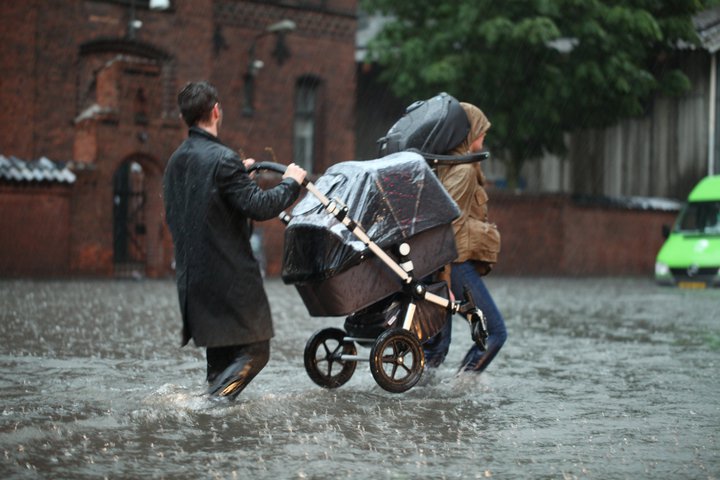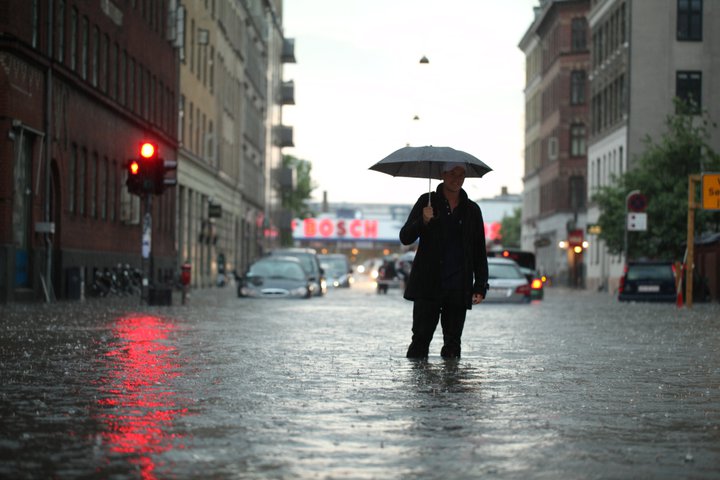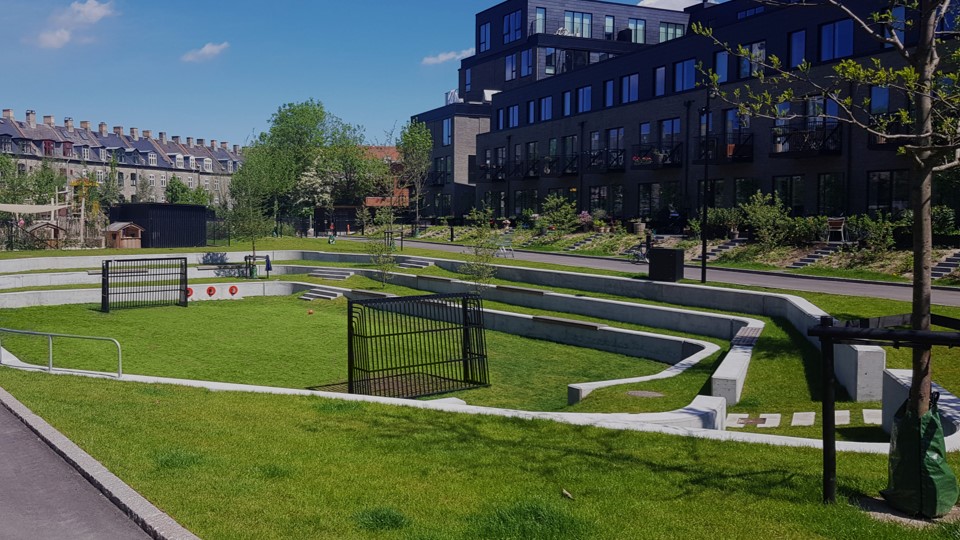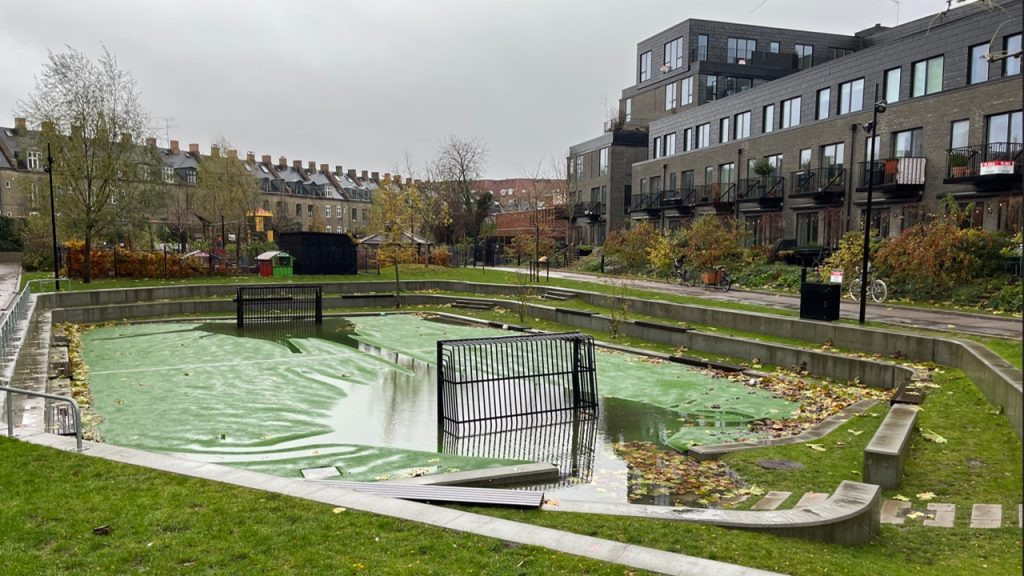– Copenhagen addresses climate change impacts by working with – not against – floodwater
Following a 1,000-year storm and flood in 2011, Copenhagen introduced a plan to manage surface water flow. NEIL MCLEAN GORING, Lead Designer, Ramboll, speaks with Robbie Cousins about how the Copenhagen Cloudburst Management Plan works and how its principles can be applied in other cities


In 2011, in less than two hours, Copenhagen was hit by an extreme one-in-1,000-year storm event.
Neil McLean Goring, lead designer with global engineering and sustainable societies consultancy Ramboll, was in Dublin at the Irish Green Building Council’s Better Homes conference in December to deliver a presentation on the Copenhagen Cloudburst Management Plan. This is a flood protection plan Ramboll helped to devise for Denmark’s capital following several catastrophic storms and massive flood events in the last decade. These floods cost the city approximately six billion Danish kroner (just over €800m) in insurance claims (physical damage), as well as having substantial socioeconomic impacts, such as citizens not being able to get to work, data loss from servers flooded, freight deliveries cancelled/impacted, etc.
Copenhagen floods
In July 2011, in less than two hours, Copenhagen was hit by an extreme one-in-1,000-year storm event – or cloudburst – where 150mm of rain left large areas of the city under up to one metre of water. There has been extreme rainfall several more times than anticipated in the years since.
Authorities in Copenhagen came to accept that the cloudbursts would not be one-off incidents; they would most likely become a more regular occurrence due to the impact of climate change. The threat is compounded, as the city’s harbour sea levels are predicted to rise one metre by 2110. In a city where many buildings and services are located below street level and where stormwater and sewage are in a combined pipe system, contaminated floodwater can easily penetrate buildings and city infrastructure. So feasible and sustainable solutions had to be found.
Traditional drainage solutions, such as underground reservoirs, are extremely expensive, lack flexibility, and only serve a singular purpose. The authorities concluded that Copenhagen could not manage extreme weather events with its conventional pipe systems, particularly as the pipes would have to be big enough for a car to drive through to manage a cloudburst event and then be empty the other 95% of the time.
Cloudburst Management Plan
The city of Copenhagen prepared the Copenhagen Cloudburst Management plan, splitting the city into eight catchment-based areas. Ramboll helped develop masterplans for four of these areas where it investigated and devised practical, pragmatic and, most importantly, feasible solutions that take into account the city’s existing infrastructure. These four masterplans are called ‘The Copenhagen Cloudburst Concretization Masterplans’.
Neil Mclean Goring explains that conventional infrastructure is generally technological, underground, and hidden, while ‘blue’ and ‘green’ solutions tend to be low-tech, on the surface, and interactive.
“The underground solutions are hidden and fixed, whereas surface solutions are accessible and flexible. Supplementing existing conventional pipe systems with blue and green interventions in the most affected catchments was the most feasible and pragmatic approach,” he says. “A blue-green approach develops a synergistic relationship between the two, integrating climate adaptation solutions within the limited confines of urban space. This is extremely difficult, so it is vital that the blue-green solutions are multifunctional and also provide recreational value, which makes blue-green infrastructure more feasible and affordable. This approach is known as the Copenhagen Cloudburst Management Plan.”
The integrated, multi-disciplinary cloudburst management plan bridges the gap between planning and site-specific solutions through the application of a typology-based cloudburst toolkit. The Copenhagen Cloudburst Management Plan identified eight central city catchment areas for action and included 300 separate projects to run over the course of 20 years.
McLean Goring continues: “The actions take a nature-based and multifunctional approach to address the city’s flood risks and include redesigning parks and streets throughout Copenhagen to retain and absorb vast amounts of stormwater like a sponge at critical periods.”


A park in Copenhagen has been adapted to store excess water at ground level – Images courtesy of Niels Nielsen from Carlsberg Byen P/S
Copenhagen Cloudburst Concretization Masterplans
Copenhagen aims to be the world’s first carbon-neutral capital city by 2025. It has been working towards this goal under the Copenhagen Climate Adaption Plan, which also came about as a result of the 2011 flood.
According to the Copenhagen Climate Adaption Plan, a primary challenge for the city in light of climate change is more and heavier downpours in the future.
The goal of the Copenhagen Cloudburst Concretization Masterplans is to reduce the impacts of pluvial flooding due to heavy rains. The plan builds on a detailed socioeconomic assessment to ascertain whether cloudburst and stormwater management can pay off for society. Previously, sewer discharge was allowed to ground level once every 10 years. With the new management plan, sewer discharge is still only allowed to reach ground level once every 10 years, but average water levels will only be permitted below kerb height to exceed ground level by 10cm once every 100 years (except in areas designated for flood control).
Copenhagen had neither the capacity nor the economic resources to implement all of the cloudburst management plan measures all at once. The plan is being operated with a minimum time frame of 20 years, requiring a prioritisation of individual projects in line with the Copenhagen Climate Adaptation Plan.
Neil McLean Goring explains: “Pluvial flood risks are being addressed locally in key catchment areas through adaptive measures to store, delay or drain excess water at ground level, such as reopening streams, constructing new channels or redesigning public space, such as park or squares, as temporary detention basins, and using roads with high kerbstones to lead the pluvial flood water into these. Where unfavourable terrain prevents surface drainage and discharge, existing and new cloudburst pipes will be needed as a last resort. In central Copenhagen, the water can be diverted to the harbour through existing large pipes.”
The two key principles of the Copenhagen Concretization Masterplans are, firstly, to separate rainwater from sewerage through blue-green surface solutions mitigating both flood risk and environmental/health impacts, and, secondly, to always seek multifunctionality.
These masterplans comprise four surface solutions as well as pipe-based solutions. These are:
- Stormwater roads and pipes that transport water towards lakes and the harbour
- Detention roads for storing waters
- Detention areas to store a very large volume of water, eg, parks that could turn into lakes during flood events
- Green roads to detain and hold back water in smaller side streets.
Copenhagen city authorities decide when they update city development plans which projects will be undertaken through a prioritisation selection, considering the following:
- High-risk areas
- Areas where measures are easy to implement
- Areas with ongoing urban development projects, and
- Areas where synergistic effects can be gained.
Redefining the functions of roads
“One of the most significant costs of the flooding in Copenhagen was water getting into building plots via basements. And, one of the big changes in mindset was around how roads should be used. In addition to being transport networks for cars, they have now become transport networks for water in flood events.
“We floated the idea to change the profile of roads. Instead of having a traditional high point in the middle, it can transport many litres of water per second if changed to a V-profile. From a hydraulic engineer’s point of view, it is a dream to see this huge cross-section to transport water away from the city. Historically, in the Mediterranean, some cities were designed with cobblestone streets set out to perform in that exact way if there was a flood, which was often the case as they were downstream of a river.”
Managing costs
Neil McLean Goring points out that the cloudburst management plan is not prohibitively expensive but can be adapted to align with a city’s or town’s available resources.
He explains, “It is a very practical solution. In Copenhagen, they set a 20- to 50-year delivery programme. The plan works on the basis that amendments will be incorporated into any new works being done. So, if the Roads Department is upgrading asphalt or repairing potholes on the street or the Drainage Department is upgrading pipe infrastructure, they look at the cloudburst management plan and incorporate the recommendations into their works.
“The real merit of the Copenhagen Cloudburst Management Plan was putting heads together and getting people talking about the subject and making sure it’s integrated in every kind of development, whether it’s a retrofit of an existing area of the city or a new development, to make sure they’re all on the same page of how to handle more extreme climate and weather events.”


Sponge Cities
In the past couple of years, Ramboll, which employs over 18,000 people worldwide, has piloted the proactive ‘sponge city’ sustainable approach further afield in New York and Melbourne, and Neil Mclean Goring says it has the potential to be adopted by other towns and cities around the world, including in Ireland.
He explains: “We were invited to pilot the plan in parts of New York. This presented different challenges to Copenhagen. Firstly, the scale of New York is way beyond Copenhagen, and we are dealing with a much broader range of stakeholders, many of whom had no interaction with each other. This made it extremely difficult to start the plan because different bodies have individual premises. For instance, Transport is sitting in one place, Water somewhere else, and they never had occasion to speak to each other. But getting them to talk proved very fruitful, and they have seen great merit in working together to develop sustainable and feasible solutions.
“The solutions being piloted in New York are much different to those applied in Copenhagen. Their infrastructure, planning processes and financial models are very different, and the plan was adapted to achieve the best outcome for them. Ramboll recently published a study called ‘Blue-Green Infrastructure: A New Business Case for NYC’, where it discovered that every $1 invested in blue-green infrastructure results in a $2 return. This study can be found at www.rebuildbydesign.org
“When we presented the concept in Melbourne, instead of trying to use pumps, dams, levies and infrastructure, Melbourne authorities wanted to develop a more naturalised green-blue system, keeping water on the surface and changing its planning tools to enable it to handle the challenges presented to it by climate change.
“Ultimately, it shows that a holistic, multifunctional and integrated cloudburst planning approach can be applied anywhere, but there are no one-size-fits-all solutions once you start putting pen to paper. However, through stakeholder engagement, solutions can be found to meet the specific of each city or town.”
Cloudbursting in Ireland
Neil McLean Goring says that every city and town has finite means and resources and needs to look at the challenges presented by climate change with this in mind and work with the resources and systems they have to devise workable solutions.
“It is all about trying to be multifunctional with the surfaces you have rather than coming up with one solution. Ireland, with its heavy rainfall, is experiencing the impacts of climate change, and flood events are going to become even more frequent. It is essential that the relevant authorities take a holistic approach and devise plans that integrate conventional, green and blue solutions, which are feasible, and that all stakeholders are part of the process of delivering these plans,” he concludes.




